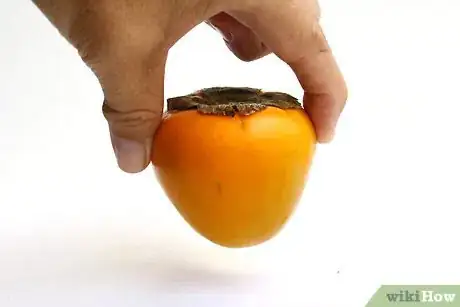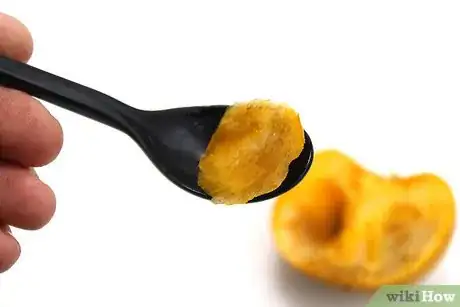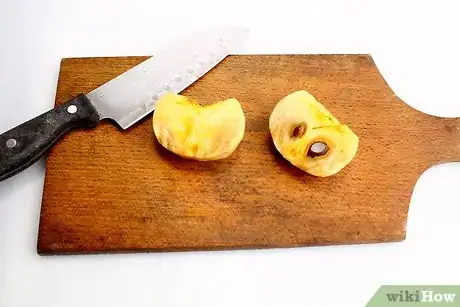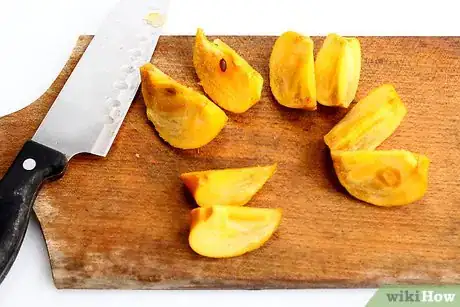This article was co-authored by wikiHow Staff. Our trained team of editors and researchers validate articles for accuracy and comprehensiveness. wikiHow's Content Management Team carefully monitors the work from our editorial staff to ensure that each article is backed by trusted research and meets our high quality standards.
There are 9 references cited in this article, which can be found at the bottom of the page.
This article has been viewed 78,724 times.
Learn more...
Persimmons are sweet and unique fruits that are rich in Vitamin A, Vitamin C, fiber, and potassium.[1] While the acorn-shaped Hachiya persimmon and the tomato-shaped Fuyu persimmon have a similar sweet and honey-like taste, they need to be cut very differently, due to their differing densities, textures, and water contents. The Hachiya persimmon is sliced in half and its inner contents are scooped out and the Fuyu persimmon is sliced in half and wedged.
Steps
Cutting a Hachiya Persimmon
-
1Place the Hachiya persimmon upright on the cutting board. When placing the persimmon, make sure it is centered and stable. You do not want the persimmon slipping off of the cutting board, squirting juice on the counter, or slipping under the knife while you are attempting to cut it.
-
2Cut the persimmon leaves at their base with a knife. Make sure to use a sharp kitchen knife, as the leaves can be thick and tough.[2] This step makes the removal of the stem and the slicing of the actual fruit easier because there will be less to get in the way of the knife.Advertisement
-
3Cut a V-shape around and underneath the stem. Make the cut shallow, so you do not cut out too much of the actual persimmon fruit. The vertical height of this V-cut is recommended to be only slightly longer than the actual stem, which can range from around one to one and a half centimeters. [3]
- You can also pull out the stem with your hands. The stem of the Hachiya persimmon should come out easily if it is fully ripe.[4] However, this method is less exact, has the potential to be messier, and can result in you pulling out too much of the actual fruit along with the stem.
-
4Slice the persimmon in half. Place the middle of the sharp knife down the center of the persimmon, where the stem used to be. Simultaneously move the knife forward as you push downward. This will slice the persimmon in half.[5]
- Make sure you are watching your hand and knife placement. If you cut yourself, wash it and put antibiotics on it. If it is more serious, seek medical attention.
-
5Scoop out the inner contents of the fruit. With a spoon, scoop the persimmon meat out of its skin.[6] An easy way to do this is by scooping out the contents from side of the persimmon, where the inner fruit meets the skin, almost like scooping an avocado. If you cannot get all the persimmon out in one scoop that is okay! Keep scooping until you are satisfied.
Slicing a Fuyu Persimmon
-
1Peel the Fuyu persimmon skin. Put pressure on the persimmon skin with the peeler as you pull the peeler back toward you. Continue this movement around the fruit until the skin is completely removed. This is optional, as the skin is edible; however, peeling the skin is helpful because it makes the persimmon less likely to slip under a knife while slicing it. [7]
-
2Position the Fuyu persimmon to stand vertically on the cutting board. When placing the persimmon, make sure it is centered and stable. You do not want the persimmon slipping off of the cutting board or slipping under the knife while you are attempting to cut it.
-
3Trim the persimmon leaves as much as possible. Make sure to use a sharp kitchen knife, as the leaves can be thick and tough. This step makes the removal of the stem and the cutting easier because there will be less excess in the way of the knife.[8]
-
4Remove the stem by cutting it out at a forty-five degree V-shape. Make the cut shallow, so you do not cut out too much of the actual persimmon fruit. The vertical height of this V-cut is recommended to be only slightly longer than the actual stem, which can be anywhere from one to one and a half centimeters.[9]
-
5Cut the persimmon in two. Place the middle of the sharp knife down the center of the persimmon, where the stem used to be. Simultaneously move the knife forward as you push downward. This will slice the persimmon in half.[10]
-
6Slice the persimmon halves into wedges. Cut the persimmon halves in half again by using the same slicing motion. Continue to cut each half into smaller halves until you are satisfied. Wedges are typically around one to two centimeters, yet can vary depending on personal preference.[11]
- If you are baking with persimmons or placing them on a platter, you may consider cutting the persimmon into incredibly thin wedges. You can slice them as thin as around one fifth of a centimeter.[12]
Warnings
- Be careful! Using sharp knives can be dangerous. When you are cutting the persimmon, be attentive. If you cut yourself, wash it and put antibiotics on it. If it is more serious, seek medical attention.⧼thumbs_response⧽
References
- ↑ https://www.webmd.com/food-recipes/fruit-month-persimmons#1
- ↑ https://harvesttotable.com/persimmons_slice_the_persimmon/
- ↑ https://www.youtube.com/watch?v=BZLWtXgi9v8
- ↑ https://www.treehugger.com/green-food/how-eat-persimmon-pro.html
- ↑ https://www.treehugger.com/green-food/how-eat-persimmon-pro.html
- ↑ http://www.organicauthority.com/the-clueless-foodies-guide-on-how-to-eat-a-persimmon-plus-delicious-recipes/
- ↑ https://www.craftybaking.com/howto/persimmons-how-cut-and-poach
- ↑ https://www.wikihow.com/Eat-a-Persimmon
- ↑ https://www.youtube.com/watch?v=BZLWtXgi9v8
About This Article
Before you cut a persimmon, figure out if you have a Hachiya persimmon, which looks like an acorn, or a Fuyu persimmon, which looks like a tomato, since they need to be cut differently. To cut a Hachiya persimmon, place it upright on a chopping board and cut off the leaves with a sharp knife. Then, cut a shallow V-shape around the stem and remove it from the fruit. Once you’ve removed the stem, slice the persimmon in half and scoop out the insides with a spoon. To cut a Fuyu persimmon, start by peeling its skin, which will make it easier to cut the fruit. Then, remove the leaves and stem in the same way as a Hachiya persimmon. After you remove the stem, cut the persimmon in 2 and slice the halves into wedges, like you’d cut an apple. For more tips, including how to remove a persimmon stem by hand, read on!


























































